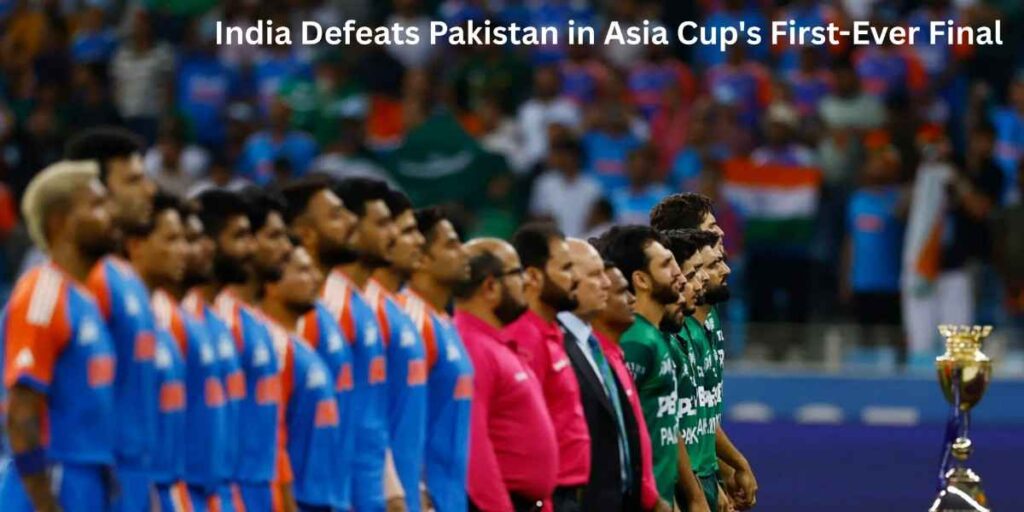India created history on September 28, 2025, defeating Pakistan by 5 wickets in the first-ever India-Pakistan Asia Cup final, extending their record with a ninth title. Tilak Varma’s nerveless 69 guided India home with just 2 balls remaining* in a thriller that lived up to 41 years of anticipation. The victory at Dubai International Cricket Stadium marked India’s unbeaten tournament campaign and continued their psychological dominance over their arch-rivals in crucial matches. This wasn’t just cricket—it was a cultural phenomenon that captured global attention, with Pakistan collapsing dramatically from 113/1 to 146 all out before India recovered from their own crisis at 20/3 to claim victory in the most anticipated final in Asia Cup history.
The significance extends beyond mere tournament silverware. After 16 previous Asia Cup editions since 1984, these two cricketing superpowers had never both reached the final until now, making this encounter a once-in-a-generation spectacle that lived up to its billing with exceptional cricket drama.
Pakistan’s promising start turns into dramatic collapse
Pakistan won the toss and chose to bat first, launching their innings with aggressive intent through Sahibzada Farhan and Fakhar Zaman. The opening pair built a commanding 84-run partnership that had Pakistan cruising at 113/1 after 12.4 overs, with Farhan playing an exceptional knock of 57 off 38 balls that included the historic feat of becoming the first batsman to hit two sixes off Jasprit Bumrah in international cricket.
Check out Rajbet welcome bonus india
But cricket’s cruel uncertainties struck Pakistan with devastating force. What followed was one of the most catastrophic collapses in recent memory—losing 9 wickets for just 33 runs in 38 balls. The introduction of Varun Chakravarthy broke the opening partnership, dismissing Farhan with a brilliant catch by Tilak Varma. The spinner then removed Fakhar Zaman for 46, triggering an avalanche.
Kuldeep Yadav proved to be the wrecker-in-chief, claiming 4/30 with his variations proving unplayable on Dubai’s turning surface. His wrong’un to Mohammad Nawaz was particularly spectacular, leaving the Pakistani batsman with a golden duck and putting Kuldeep on a hat-trick. The leg-spinner’s four-wicket burst in the death overs exemplified India’s bowling depth and tactical acumen.
Pakistan’s final total of 146 represented a massive underachievement from their commanding position. Axar Patel and Jasprit Bumrah provided excellent support to the spinners, with the bowling unit demonstrating the variety that had made them tournament favorites.
Connect your online cricket id provider with asia play
India’s recovery from early disaster showcases championship character
India’s chase began disastrously, slumping to 20/3 within the powerplay as Pakistan’s seamers struck early blows. Faheem Ashraf removed both Abhishek Sharma (5) and Shubman Gill (12), while captain Suryakumar Yadav fell cheaply to Shaheen Shah Afridi for just 1 run. At 36/3 after six overs, India faced their lowest powerplay score of the tournament.
Enter Tilak Varma, the 22-year-old left-hander who would script one of the finest final innings in recent memory. Initially struggling against Pakistan’s slower deliveries, Tilak showcased remarkable tactical awareness by targeting pace bowler Haris Rauf in the 15th over, smashing 17 runs to shift momentum decisively. His partnership with Sanju Samson (24 off 21) added 57 crucial runs before Samson fell to leg-spinner Abrar Ahmed.
The match-winning partnership came through Tilak’s association with Shivam Dube, who contributed a vital 33 off 22 balls with calculated aggression. Their 60-run stand off just 40 balls demonstrated perfect game management under pressure. Dube’s six over wide long-on off Faheem Ashraf showed his ability to read the bowler’s plans and counter-attack effectively.
With 10 runs needed from the final over bowled by Rauf, Tilak sealed victory with a magnificent six over square leg with 8 balls remaining, finishing unbeaten on 69 off 53 balls with 4 sixes and 3 fours. His strike rate of 130.19 perfectly balanced aggression with responsibility in cricket’s highest-pressure environment.
Complete Match Scoreboard
PAKISTAN INNINGS: 146 all out (19.1 overs)
BATTING SCORECARD
| Batsman | Dismissal | Runs | Balls | 4s | 6s | SR |
| Sahibzada Farhan | c Tilak Varma b Chakravarthy | 57 | 38 | 5 | 3 | 150.00 |
| Fakhar Zaman | c Gill b Kuldeep Yadav | 46 | 35 | 2 | 2 | 131.42 |
| Saim Ayub | lbw b Axar Patel | 14 | 11 | 2 | 0 | 127.27 |
| Mohammad Rizwan (wk) | c Axar b Kuldeep Yadav | 7 | 8 | 1 | 0 | 87.50 |
| Mohammad Nawaz | b Kuldeep Yadav | 0 | 1 | 0 | 0 | 0.00 |
| Iftikhar Ahmed | c Samson b Bumrah | 4 | 6 | 0 | 0 | 66.67 |
| Faheem Ashraf | c & b Axar Patel | 6 | 8 | 1 | 0 | 75.00 |
| Shadab Khan (c) | c Sharma b Kuldeep Yadav | 3 | 5 | 0 | 0 | 60.00 |
| Shaheen Afridi | c Yadav b Bumrah | 2 | 3 | 0 | 0 | 66.67 |
| Haris Rauf | not out | 5 | 3 | 1 | 0 | 166.67 |
| Abrar Ahmed | b Chakravarthy | 0 | 1 | 0 | 0 | 0.00 |
| Extras | (lb 1, w 1) | 2 | ||||
| TOTAL | (19.1 overs) | 146 |
FALL OF WICKETS: 1-84 (Farhan, 12.4 ov), 2-113 (Fakhar, 14.1 ov), 3-117 (Ayub, 14.5 ov), 4-117 (Nawaz, 14.6 ov), 5-124 (Rizwan, 16.2 ov), 6-128 (Iftikhar, 17.1 ov), 7-134 (Shadab, 18.1 ov), 8-139 (Shaheen, 18.4 ov), 9-144 (Faheem, 19.0 ov), 10-146 (Abrar, 19.1 ov)
INDIA BOWLING
| Bowler | Overs | Maidens | Runs | Wickets | Economy |
| Jasprit Bumrah | 3.1 | 0 | 25 | 2 | 7.89 |
| Arshdeep Singh | 3 | 0 | 28 | 0 | 9.33 |
| Varun Chakravarthy | 4 | 0 | 30 | 2 | 7.50 |
| Axar Patel | 4 | 0 | 26 | 2 | 6.50 |
| Kuldeep Yadav | 4 | 0 | 30 | 4 | 7.50 |
| Hardik Pandya | 1 | 0 | 6 | 0 | 6.00 |
INDIA INNINGS: 150/5 (19.4 overs)
BATTING SCORECARD
| Batsman | Dismissal | Runs | Balls | 4s | 6s | SR |
| Abhishek Sharma | c Rizwan b Faheem | 5 | 7 | 1 | 0 | 71.42 |
| Shubman Gill | c Ayub b Faheem | 12 | 10 | 2 | 0 | 120.00 |
| Suryakumar Yadav (c) | c Rizwan b Shaheen | 1 | 3 | 0 | 0 | 33.33 |
| Sanju Samson (wk) | c Faheem b Abrar | 24 | 21 | 2 | 1 | 114.28 |
| Tilak Varma | not out | 69 | 53 | 3 | 4 | 130.19 |
| Shivam Dube | c Shadab b Faheem | 33 | 22 | 2 | 2 | 150.00 |
| Hardik Pandya | not out | 4 | 2 | 1 | 0 | 200.00 |
| Extras | (lb 1, w 1) | 2 | ||||
| TOTAL | (19.4 overs, 5 wickets) | 150 |
DID NOT BAT: Axar Patel, Varun Chakravarthy, Kuldeep Yadav, Arshdeep Singh, Jasprit Bumrah
FALL OF WICKETS: 1-13 (Sharma, 2.3 ov), 2-15 (Suryakumar, 3.2 ov), 3-20 (Gill, 4.1 ov), 4-77 (Samson, 12.4 ov), 5-137 (Dube, 18.5 ov)
PAKISTAN BOWLING
| Bowler | Overs | Maidens | Runs | Wickets | Economy |
| Shaheen Afridi | 4 | 0 | 20 | 1 | 5.00 |
| Faheem Ashraf | 4 | 0 | 29 | 3 | 7.25 |
| Haris Rauf | 3.4 | 0 | 41 | 0 | 11.18 |
| Abrar Ahmed | 4 | 0 | 29 | 1 | 7.25 |
| Shadab Khan | 4 | 0 | 30 | 0 | 7.50 |
RESULT: India won by 5 wickets (with 2 balls remaining)
PLAYER OF THE MATCH: Tilak Varma (69* off 53 balls)
PLAYER OF THE TOURNAMENT: Abhishek Sharma (314 runs in 7 matches)
BEST BOWLER OF THE TOURNAMENT: Kuldeep Yadav (17 wickets)
Key Partnerships
Pakistan:
- 1st wicket: 84 runs (Farhan & Fakhar) – 12.4 overs
- 2nd wicket: 29 runs (Fakhar & Ayub) – 1.3 overs
India:
- 4th wicket: 57 runs (Tilak & Samson) – 8.3 overs
- 5th wicket: 60 runs (Tilak & Dube) – 6.1 overs – Match-winning partnership
Individual brilliance defines tournament legacy
Tilak Varma’s Player of the Match performance represented more than just statistics—it showcased the mental fortitude required for cricket’s biggest stage. His ability to adapt mid-innings, switching from cautious accumulation to calculated aggression, demonstrated the tactical intelligence that separates good players from great ones. “One of the most special knocks of my life. This is for all the Indians,” Varma said post-match, perfectly capturing the emotional weight of his achievement.
Abhishek Sharma’s Player of the Tournament award came from his record-breaking 314 runs across 7 innings, surpassing Mohammad Rizwan’s previous T20 Asia Cup record of 281 runs. His strike rate of 204.64 throughout the tournament perfectly epitomized India’s aggressive approach, contributing nearly 40% of India’s total runs during their unbeaten campaign.
Kuldeep Yadav’s tournament-leading 17 wickets culminated in his Player of the Final performance with 4/30. His variations on turning UAE pitches proved unplayable for most batsmen, with the wrong’un to Mohammad Nawaz serving as the perfect example of his mastery over flight, turn, and deception.
The supporting cast also delivered crucial contributions. Sahibzada Farhan became the first player to hit multiple sixes off Jasprit Bumrah in T20 internationals, while his opening partnership with Fakhar Zaman demonstrated Pakistan’s batting potential that makes their collapse even more disappointing.
Records and milestones mark historic achievement
This final created multiple pieces of cricket history beyond the obvious first India-Pakistan Asia Cup final. India’s ninth Asia Cup title extended their record as the tournament’s most successful nation, with this T20 triumph adding to their previous eight victories across different formats.
The tournament format itself set new standards, featuring 8 teams for the first time in Asia Cup history and being held entirely in a neutral venue due to political tensions. India’s unbeaten run through all six matches demonstrated their depth and consistency across conditions.
Individual milestones included Abhishek Sharma’s single-edition run-scoring record, Kuldeep Yadav’s exceptional wicket-taking spree, and Tilak Varma’s emergence as India’s new middle-order anchor. The left-hander’s 213 runs in 7 tournament matches at a strike rate of 130+ showcased the perfect balance modern T20 cricket demands.
Political tensions overshadow cricket celebration
The match’s aftermath proved as dramatic as the cricket itself, with India refusing to accept the trophy from ACC President Mohsin Naqvi, who also serves as Pakistan’s Interior Minister and PCB Chairman. This unprecedented protest delayed the presentation ceremony by over an hour and highlighted the deep political tensions that have affected cricket relations between the nations.
Throughout the tournament, teams refused handshakes on match referee advice, conducted separate toss ceremonies, and dealt with various provocative incidents. The mock trophy celebration by Indian captain Suryakumar Yadav symbolized how political realities continue influencing cricket’s greatest rivalry, even in moments of sporting triumph.
These tensions stemmed from the broader context of 2025’s military conflicts and the tournament’s relocation from India to the UAE, demonstrating how cricket often becomes a proxy for larger geopolitical dynamics between these neighbouring nations.
Conclusion
The India vs Pakistan Asia Cup 2025 final delivered everything cricket fans could have hoped for after a 41-year wait: exceptional individual performances, dramatic momentum shifts, match-defining partnerships, and a finish that went to the final over. Tilak Varma’s match-winning 69 will be remembered alongside the greatest final innings in Asian cricket history*, while Pakistan’s collapse from 113/1 serves as a reminder of cricket’s capacity for cruel plot twists.
Beyond the immediate sporting drama, this match represented the culmination of modern cricket’s most compelling narrative—the India-Pakistan rivalry reaching new heights despite political obstacles that continue threatening bilateral cricket. India’s victory maintained their psychological dominance while extending their continental supremacy, but the quality of cricket showcased by both teams suggests this rivalry’s sporting appeal transcends any off-field controversies.
The emergence of new heroes like Tilak Varma and Abhishek Sharma, combined with the continued excellence of established stars like Kuldeep Yadav, provides optimism for cricket’s future in the subcontinent. Most importantly, this final proved that when these two teams meet on cricket’s biggest stages, the result is invariably unmissable theatre that justifies every bit of anticipation—even when that wait lasts four decades.





